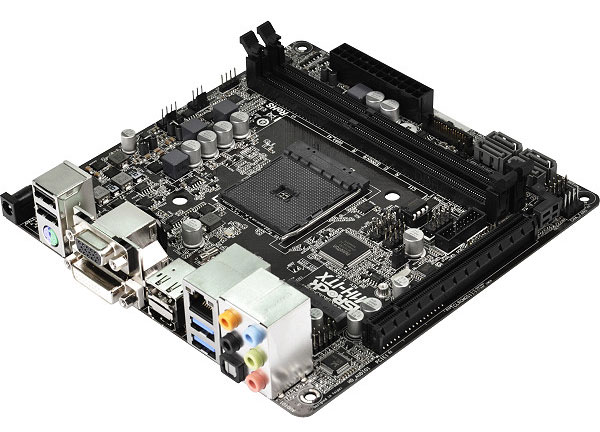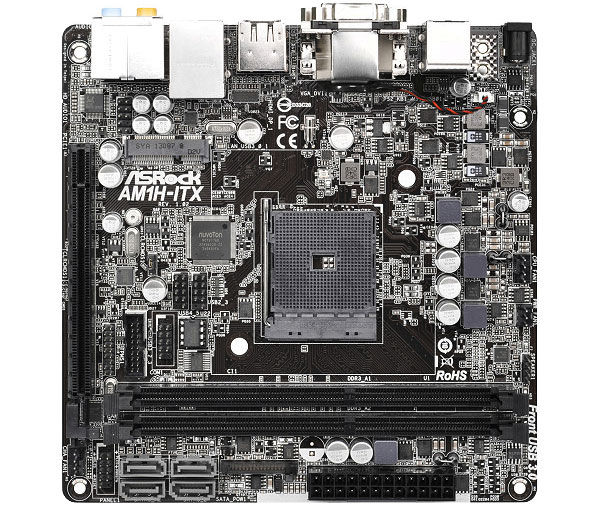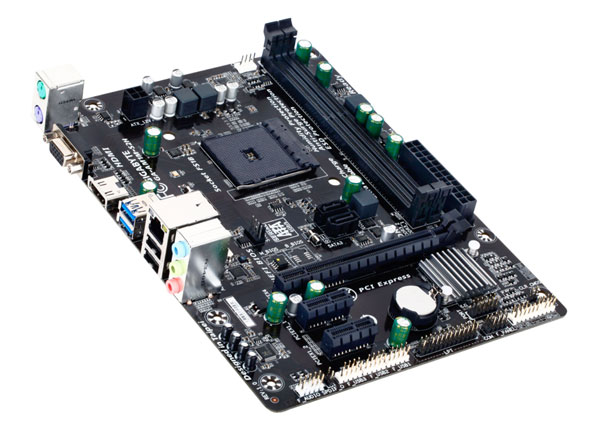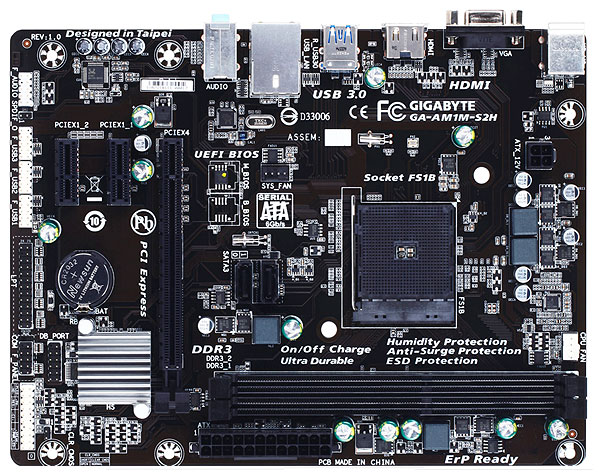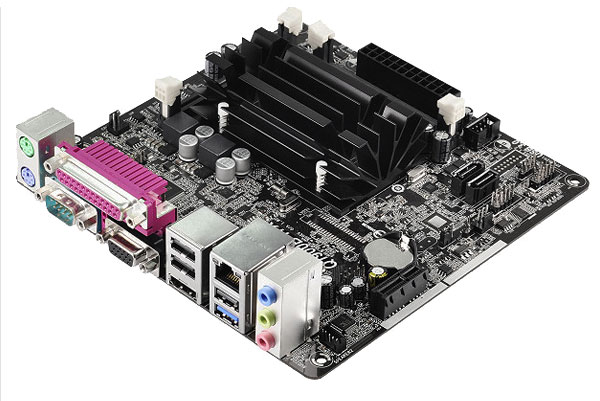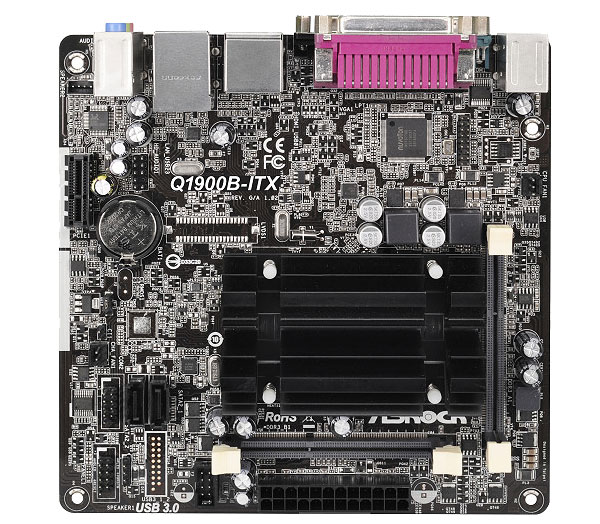AMD Athlon 5350 And AM1 Platform Review: Kabini In A Socket
AMD is repackaging the mobile-focused Kabini APU for use on the desktop, and tucking them under the familiar Athlon and Sempron brands. We take a closer look at the company's socketed AM1 platform and compare its performance to Intel's Bay Trail-D.
One Bay Trail-D And Two AM1 Motherboards
We're testing two AM1 motherboards and a single Bay Trail-D platform.
ASRock AM1H-ITX
ASRock's AM1H-ITX is, as its name suggests, a mini-ITX board. Measuring just under 7" square, it doesn't occupy much space. Yet it offers an impressive number of interesting features. For instance, the platform comes equipped with an ATX power connector, but it can by driven by a 19 V DC adapter (and it has the corresponding input to prove it).
You get a lot of connectivity, given the motherboard's footprint. There are two USB 3.0 and two USB 2.0 ports on the I/O panel (plus a USB 3.0 header on-board), four display outputs (VGA, DVI, DisplayPort, and HDMI), GbE, and eight-channel audio with an optical output.
On the board itself, you'll find four SATA connectors, a SATA power connector, two DDR3 memory slots, a PCIe x16 expansion slot, mini-PCIe for a wireless card, and a trio of fan headers, one of which is for the APU. That's a comprehensive suite of features, to be sure.
Gigabyte AM1M-S2H
Measuring roughly 6.5" x 9", Gigabyte's AM1M-S2H is a slightly larger microATX motherboard. The extra length creates room for two PCIe x1 slots, in addition to a PCI Express x16 slot. Gigabyte's I/O panel features VGA and HDMI video outputs, two USB 3.0 and two USB 2.0 connectors, GbE, and three analog audio outputs.
The board also hosts two SATA connectors, a pair of DDR3 memory slots, two fan headers, and three more USB 2.0 headers for additional peripheral connectivity.
ASRock Q1900B-ITX
Our Bay Trail-D representation also comes complements of ASRock in the Q1900B-ITX, armed with an integrated Celeron J1900 CPU. The rest of the board's attributes reflect a similar approach: it employs SO-DIMM slots and a single PCI Express x1 interface, with no support for full-sized graphics cards.
Get Tom's Hardware's best news and in-depth reviews, straight to your inbox.
Moreover, the back panel hosts legacy parallel and serial ports, exposing the platform's embedded focus. You do get one USB 3.0 port, three USB 2.0 connectors, a VGA output, and HDMI connectivity. GbE and six-channel audio output are standard fare.
ASRock enables two fan headers, a USB 2.0 header, and a pair of SATA ports on the little board's surface. Passive cooling is made possible by the Celeron, which is another reason Intel's approach works so well in industrial environments.
Current page: One Bay Trail-D And Two AM1 Motherboards
Prev Page The AM1 Platform: Kabini Surfaces On The Desktop Next Page Test Systems And BenchmarksDon Woligroski was a former senior hardware editor for Tom's Hardware. He has covered a wide range of PC hardware topics, including CPUs, GPUs, system building, and emerging technologies.
-
AMD Radeon i hope mini office pc box can be a new trendReply
AM1 can be a potential winner in this market -
Maxx_Power To Toms:Reply
What was the ambient temperature during the testing ? Surely Toms is not testing in an refrigerator ? That idle GPU and CPU temperature at 13 degrees Celsius seems about 10 degrees too low, given that they have to be necessarily above ambient conditions to make physical sense. Perhaps the sensors are not read correctly (wrong offset) ?
For the Dota2 graphs, there seems to be a mistake for the color legend. The difference in color isn't resolution, since the resolution is fixed (right hand top corner of graph at 1080), so my guess is that red/black represents min/avg FPS similar to the 2nd graph on Grid2.
-
nezzymighty Thanks for the article. I agree with your conclusion, as I would probably seek an alternative build for a a "PC-Like Device" as you put it. Seeing AM1 product costs relatively the same to an A4-4000 FM2+ confuses me, as I had originally expected (hoped) AM1 high-end combinations with a motherboard to cost around the $70 mark... If I were to make an AMD HTPC, or a typical AMD business computer, based on prices released by the e-tailers today, it would make more sense for me to build an FM2+ with A4-4000. Maybe prices will reduce in time to make this a more attractive alternative relative to an FM2+ for an HTPC or business computer.Reply -
ykki "Based on our results, I'd guess that AMD's AM1 platform should be able to handle less-demanding MMOs like World of Warcraft, lightweight shooters like Left 4 Dead, and a wide range of even more casual games (such as Angry Birds)."Reply
I think that it is safe to say that it can max out angry birds at 4k :) -
cleeve Reply13061890 said:To Toms:
What was the ambient temperature during the testing ? Surely Toms is not testing in an refrigerator ? That idle GPU and CPU temperature at 13 degrees Celsius seems about 10 degrees too low, given that they have to be necessarily above ambient conditions to make physical sense. Perhaps the sensors are not read correctly (wrong offset) ?
On-die sensors are notoriously inaccurate at low temperatures. In this case that's obvious, but we can only report what the sensors tell us.
13061890 said:For the Dota2 graphs, there seems to be a mistake for the color legend. The difference in color isn't resolution, since the resolution is fixed (right hand top corner of graph at 1080), so my guess is that red/black represents min/avg FPS similar to the 2nd graph on Grid2.
Good catch! Fixed. :)
